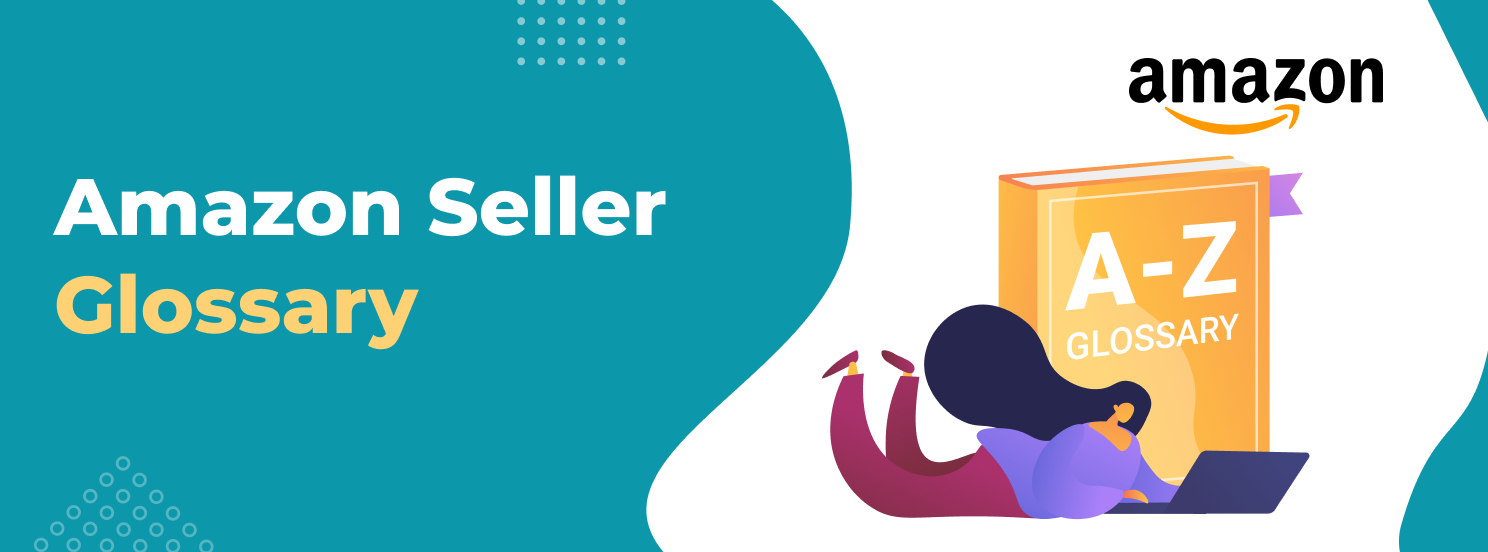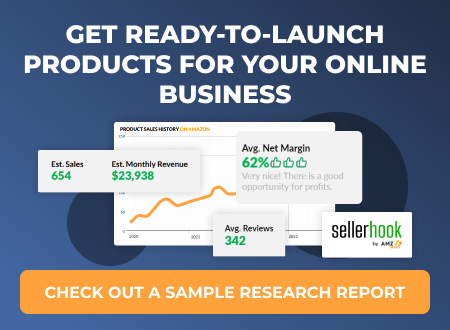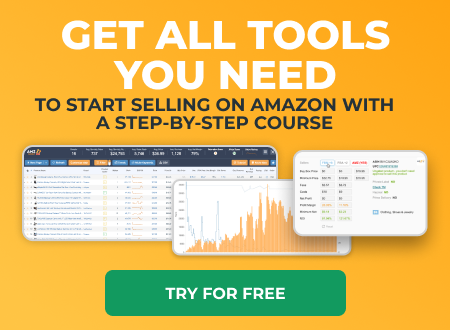
Amazon Acronyms and Terminology for New Sellers
Starting with Amazon sales, sellers may encounter an intimidating amount of terms and Amazon acronyms. So here is a list of key terminology you may see frequently as you get to know the Amazon platform and product analytics tools, like AMZScout. Check out this glossary to help you gain a better understanding of Amazon lingo and terminology.
Amazon Seller Glossary
Methods for Selling
There are two main types of sellers on Amazon: businesses and individuals. Once you choose the right type for you, you have to select one of the following selling methods available:
Dropshipping – A method of order fulfillment, where the seller purchases inventory from a third party — to fulfill orders only, and doesn’t keep any products on their own. With dropshipping, the seller doesn’t hold any physical inventory, they only act as the middleman.
Flipping – Selling a product at a higher price than the seller paid for it. Go deeper, and discover price differences at different marketplaces. The trick here is understanding the secret of finding the best products.
Online arbitrage (OA) – This involves buying from online retailers only to resell at a higher price on another online marketplace such as Amazon, eBay, or Facebook Marketplace.
PL (Private Label) – This term means that only one seller on Amazon offers this product, or a particular brand sells their products only. Not appropriate for dropshipping and OA.
Reselling – The method of selling when an individual or business does not manufacture their goods, but rather purchases large amounts of goods from a third party, and then sells them on Amazon or another marketplace for a higher price.
Retail Arbitrage (RA) – A method of selling where the seller buys discounted products from brick-and-mortar stores to sell on Amazon at a normal or higher price.
Wholesale – Purchasing bulk branded products from an original manufacturer, another supplier, or distributor. The goal here is reselling to consumers. The most popular wholesale categories are consumer electronics, kitchenware, and toys.


Product Features and Codes Glossary
Once you’ve decided on your selling method, it’s time to choose which products you want to purchase and sell. Here are a few abbreviations and terms you may come across while exploring products on the platform.
ASIN – A unique Amazon product identifier number. Each unique product on Amazon is marked with its own individual ASIN.
BOLO (Be On Look Out) – This term refers to any goods worth purchasing to resell on Amazon, and usually fits best with Retail Arbitrage. There are many BOLO Groups on Facebook.
BSR (Best Seller Rank) – An abbreviation for the comparison to the same category of products, showing how well the product is selling (the lower it is, the better).
Buy Box – A section on the right side of each product page, including a "Buy Now" button, with a hierarchical list of other buyers listed below. This is often based on past sales history and is sometimes rotated between sellers.
EBC (Enhanced Brand Content) – This feature allows Amazon brand owners to modify their listings with bright pictures. Sellers can add both images and additional text in order to convey a brand’s story.
Gated products – This refers to any «Closed» products that require additional certificates to get approval for selling on Amazon. Ungated products do not require any extra approval and are much easier to start selling.
GTIN (Global Trade Identification Number) – Includes UPC, ISBN, and EAN.
Hazardous Materials (Hazmat) – These are defined as any potentially flammable, corrosive, etc. goods that can be dangerous to one’s health, property, or environment, and are forbidden for eCommerce. Starting your business by selling non-hazardous goods is much easier because there is no need to obtain any extra certificates or approvals from Amazon for hazmat items.
ISBN (International Standard Book Number) – This is the code used for bookmarking as an identificator, instead of Amazon ASIN.
SKU (Stock Keeping Unit) – A unique code containing both letters and numbers that identifies the unique characteristics of every product — brand and manufacturer, style, color, and size. Retailers use SKUs to identify and track their stock and inventory.
TM (Trademark) – A symbol indicating possible risks of copyright, trademark, or patent claims related to the presence of a registered trademark for this product.
UPC (Universal Product Code) – A 12-digit bar code that is extensively used for retail packaging in the US.
Product Metrics
When searching for the right product, you have to be ready to learn which product metrics to consider first. All of these are important for your future sales, so be sure to review the following to learn more:
ACoS (Advertising Cost of Sale) – The average percentage of how much you’ve spent on advertising, regarding sales. ACoS helps you measure the success of your advertising campaigns on Amazon, and is used to help you determine the necessary adjustments for optimizing those campaigns.
COGS (Cost of Goods Sold) – An Amazon acronym used for metrics used for accounting, showing how much you paid for your products.
CTR (Click Through Rate) – The percentage of shoppers who see your ads and click on them. Divide the number of total clicks by total impressions to get this amount.
Fees – The fees subtracted from your sales by Amazon. For FBМ, this is just a marketplace fee; for FBA, it also includes delivery and warehouse fee.
Keyword Ranking – This refers to your overall position in search term engines for a specific word or phrase. When a customer searches your specific keyword, the keyword rank changes, and shows how far down your listing is. This means if you have a keyword rank of 10, your listing is the 10th down from the top.
Keyword Ranking vs. BSR
BSR indicates product sales, in terms of other products belonging to the same category.
Keyword Rank is the definition of your overall position in search for a specific word/phrase.
So when a customer types in your specific keyword into a search, keyword rank shows how far down your listing is.
ROI (Return on Investment/Return on Costs) – Ratio between the net income and initial investment. A high ROI shows that the gains compared to the initial cost are good. Widely used in eCommerce.


AMZScout Terminology and Codes
Now, you probably realize that it’s a good idea to learn more about your selected products, and ensure they best fit your needs. Here, it’s wise to use a set of specific product analytics software, like AMZScout Product Finder. Using these tools, you might encounter more metrics to learn. AMZScout’s specific terminology will enable you to use each tool’s functionality more efficiently.
Add a product to the tracker – An action for adding a product to a product tracker (WebApp).
Average monthly revenue – The average revenue per month in this niche
Average monthly sales – The average number of sales per month in this niche
Average net margin – The average net margin, meaning revenue minus expenses(fees), in this niche
Average price – The average price in this niche
Average rank – The average rank in this niche
Average reviews – The average number of reviews in this niche
BSR 30 – An average BSR for the last 30 days. With good sales on a good day, other tools might get tricked, like the goods are currently selling well not only now, but historically as well. AMZScout software provides a fuller and more accurate real picture of sales history due using incorporation of data over a longer period of time.
Estimated revenue – Estimated revenue per month.
Estimated sales – Estimated sales per month.
FBA Fee – The fee a seller must pay if they are going to sell the product through FBA: these include shipping, packing, storage + referral fee (for using the marketplace). The referral fee (15%) is paid both by FBA and FBM sellers. FBA fees include monthly storage, pick & pack, and referral fee.
Get Niche Keywords – You'll see the keywords in the niche with a number. This number shows how many times this keyword is used in the titles in this niche.
Inventory 999 – The metric that shows that a seller has more than 1,000 items in stock.
Keyword Rank – The definition of your overall position in a search term engine for a specific word or phrase. When a customer types a specific keyword into a search engine, keyword ranking accounts for how far down your listing is. For example, if you have a keyword rank of 10, you will be the 10th listing down from the top.
LQS (Listing Quality Score) – The metric used to determine the listing quality. You can increase your listing quality and override your competitors. Keyword length and richness of a listing's title, its bullet points and description, the number of pictures, and the resolution of the photos are all factors. This score can range from 1 to 100 in the AMZScout system. Try to reach 100 for an excellent listing.
Margin represents the percentage of total sales revenue that a company keeps as the gross profit after deducting the costs directly related to producing the goods or services sold (e.g., the cost of the product, fees, etc). The Extension PRO doesn’t show the cost of the product, so it is only possible to deduct fees. A percentage of 20-30% is considered a good margin.
Min Price – The minimum price for all sellers who sell the product.
Net – The amount of money taken by the seller from selling one unit of the product.
Niche History – A graph with historical information about rank, sales, and price (in this niche) over two years.
Niche Idea – Helps you to find a good niche based on sales and profit data.
Niche Score – A score for the niche based on revenue, competition, and demand (1 – it's extremely difficult to succeed in this niche, 10 – it's very likely to succeed in this niche).
Number of sellers – How many sellers sell the item within a listing. Only one wins the Buy Box, and they get 80% of the sales.
Price 30 – An average price for the last 30 days.
Product history – A graph that shows product history for the last year. This is based on rank, price, and sales.
Product Score – This metric is based on revenue, amount of reviews, and listing quality (1 – extremely difficult to succeed with this product, 10 – very likely to succeed with this product).
Product Score for Private Label indicates the demand (high or low), competition, and if margins for Private Labeling are good. The Product Score ranges from 1 to 10. Aim for 10 for the best product.
Product Score for Reselling indicates the eCommerce demand (high or low), competition, and if margins for reselling with an Online Arbitrage, Wholesale or Dropshipping model are good. The Product Score ranges from 1 to 10. Aim for 10 for the best product.
RPR (Revenue Per Review) – An Amazon acronym used to depict the monthly revenue of a seller divided by the number of reviews they have. A high RPR is good.
Visibility Score – The metric showing how many sellers found this niche during this month (1 – unsaturated, less than 10 people, 10 – extremely saturated). The fewer the codes, the better it is, as it means there will be less competition.


Profit Calculator glossary
Additional monthly costs – Any additional expenses related to your product.
Additional per unit cost – The initial price of every item in your product purchased including advertising, cost of shipping, and other additional costs.
Estimated monthly profit – Estimated revenue/one month based on statistics.
Estimated monthly sales – Estimated number of items sold/one month based on statistics.
Net Margin – The profitability of a deal: your product cost in relation to revenue.
Product cost – The initial price of the product you purchase to further resell it on Amazon or another eCommerce platform.
Product price – The price of a particular product found out by the AMZScout tool.
Product size – The size of the final product to be shipped (18” x 14” x 8” is recommended).
Product weight – The weight of the final product to be shipped (below 5 lbs is recommended).
Profit per unit – The revenue you’ll make/one item of your product.
Logistics
Well-managed logistics can guarantee better loyalty and greater sales. Logistics on Amazon can go in a variety of ways depending on which selling method you choose. Read the following terms below to be sure you are doing everything right:
3PL (Third-party Logistics) – An abbreviation used to describe the outsourced logistics services provider. Usually offers shipments, storage, and fulfillment as well.
A-to-Z Guarantee – A program from Amazon that guarantees good condition and timely delivery of purchased third-party goods. Amazon customers can file claims against sellers under this program. This has a significant impact on trading accounts, so it is very important to keep customers happy.
Amazon Vendor Central – A web interface for contracting Amazon. Manufacturers and distributors sell their products on Amazon and on behalf of Amazon. Essentially, by choosing to sell through Vendor Central, you are acting as an Amazon supplier and selling your Amazon items in bulk. Then Amazon independently sells your products online.
Distributor – Third parties work directly with brand manufacturers. Distributors buy goods in bulk from the manufacturer, and then resell them directly to consumers or retail outlets. Distributors actually own the products they sell and keep inventory. They are responsible for getting the products to the stores, so when the stores need more products, they order from the distributor instead of the manufacturer. The distributor's profit is the difference between the manufacturer's initial price and Amazon's final price.
EXW (Ex Works) – The term International Trade refers to an agreement under which the seller is obligated to prepare the goods for collection at his own place of business. Other transportation costs and risks are borne by the buyer. This means that Amazon sellers must cover shipping costs from the factory or wholesaler.
FBA (Fulfillment by Amazon) – A program that implies sellers allow Amazon to handle and ship their goods to end customers.
FBM (Fulfilled by Merchant) – An Amazon acronym that refers to the situation when a third-party seller ships their products to the end customer on their side.
FC (Fulfillment Center) – Stands for an Amazon office, where your FBA products are sent. They are stored and prepared here and shipped from here once they are sold.
Prep center – An Amazon service that receives, inspects, and prepares your inventory before shipping it to Amazon.
Prime delivery – An option for faster delivery. For example, buyers can subscribe for products fulfilled by Amazon. For OA sellers and dropshippers, it’s recommended not to support Prime delivery in order not to focus on very fast delivery.
SFP (Seller Fulfilled Prime) – Refers to a program that allows offering express Prime shipping using Amazon’s approved carriers directly from the seller's own warehouse.
TOT (Time Off Task) – The time used by Amazon to describe any break a worker takes from scanning packages that is too long.
Vendor – A business or individual who sells goods directly to Amazon. In the Amazon Vendor program, Amazon purchases items wholesale in order to sell them later online.
Suppliers
When selling on Amazon, you will surely communicate with suppliers periodically. In order to operate your supplies and warehouse efficiently, you need to be familiar with these useful terms:
MAP (Minimum Advertised Price) – A minimum price that a brand allows sellers to show when listing their product.
MOQ (Minimum Order Quantity) – The minimum order size that a manufacturer allows for a certain product. Negotiable.
MSRP (Manufacturer’s Suggested Retail Price) – The price at which the manufacturer recommends selling their products. For the UK, this is known as RRP (Recommended Retail Price).
OEM (Original Equipment Manufacturer) – An original producer of goods to be sold by another manufacturer.
Conclusion
With this A-to-Z Amazon and AMZScout glossary, you can learn the basics of selling on Amazon, and start making sales fast and efficiently. Use this terminology whenever you are unsure of what your next step should be. Try out AMZScout tools for more success with your sales today.






